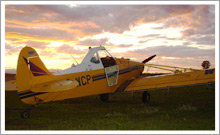Aug. 19, 2011, issue of 'AOPA ePilot: Flight Training Edition' newsletter
| ||||
| | FT News | INSIDE AOPA | TRAINING PRODUCTS | FINAL EXAM | |||
TRAINING TIPs The fuel left behind The training environment doesn't always realistically consider fuel needs. Local training flights routinely go out full—except some two-seat trainers with low useful loads—and flight lessons may be too brief to call fuel quantity into question. Cross-countries are an exception. After you fly one, compare your actual fuel consumption to your preflight estimates. Discuss any difference with your flight instructor. For a light but telling look at pilots' sometimes-too-casual approach to fuel planning, see this Pilot Safety Announcement from the Air Safety Institute. On solo cross-countries, taking off with full fuel and refueling at the farthest point from home is standard practice and cheap insurance against fuel problems that could result from deviations around unexpected weather, or even getting lost. Prepare for that future day when carrying maximum fuel may not be the sound-and-simple judgment call that it is now. That might happen when you are faced with a flight with passengers and baggage from a short runway or under high-density-altitude conditions. Flying responsibly with a partial fuel load requires a reliable method of measuring the fuel supply. Use a calibrated dipstick, making sure that the aircraft is on level ground when you "stick the tanks." En route, think of fuel consumption in terms of hours and minutes, rather than gallons, and keep careful track of time remaining (allowing for reserves). “If you know how many minutes of fuel you have and how long it will take to reach your destination or fuel stop, it's easy to know if you'll need your reserve,” says the Air Safety Institute's Fuel Awareness Safety Advisor. Adjust for any long climbs or changes to your planned power setting. Fuel burns stated in your pilot's operating handbook will only be delivered by the designated method of leaning the mixture. Keep up your calculations, regardless of what the fuel gauges say! Their unreliability has drawn many cautionary warnings, yet remains causal in numerous fuel-exhaustion accidents. Research has sought to determine where the margin of error lies in pilots' variable ability to estimate fuel values. What emerged was that many pilots needed to crunch their numbers more carefully. YOUR PARTNER IN TRAININGLooking for tips to become a better pilot? We’ve got 25 of them, in no particular order. From short-field landings to new ratings, Budd Davisson’s suggestions will challenge you to fly more efficiently. Read more from the September 2001 issue of Flight Training . Did you know that student pilots who join AOPA are three times more likely to complete their flight training? Membership includes unlimited access to aviation information by phone (800/USA-AOPA, weekdays from 8:30 a.m. to 6 p.m. Eastern time) or from Flight Training Online or AOPA Online. If you're not already a member, join today and get the pilot’s edge. Login information is available online. FLIGHT TRAINING NEWSEastern Kentucky U gets new chief flight instructorEastern Kentucky University has named Ralph Gibbs chief flight instructor of the college’s aviation program. During a 26-year career with the U.S. Marine Corps, Gibbs was flight instructor with the Naval Aviation Training Command. Since retiring from the military, he taught at community and technical colleges in Oregon, according to KentuckyForward.com. What's outside your window?The weather you see when you look out your window is but a small part of a larger air mass. But what does that mean to you as a pilot who relies on weather data to make important decisions? Learn about the different air masses and their characteristics with the WeatherWise: Air Masses and Fronts online course from the Air Safety Institute. Texas airport manager develops future pilots earlyThe manager of the Pecos Municipal Airport in Pecos, Texas, believes in developing future pilots as early as possible. Isabel Blanchard, who started managing the airport in 1985 at age 23, brings out kindergarten students and lets them climb into a Cessna and try out the controls. As many as 300 children per year come to the airport, according to MyWestTexas.com. Blanchard says some of those students will return to the airport years later and learn to fly. Ala. teen sets eyes on the skiesLast year, high school senior Amber Hubert flew in small airplanes to visit a relative and to attend a basketball camp at the University of Maryland. This year she’s behind the controls as she works toward obtaining a pilot certificate. Hubert, a resident of Atmore, Ala., has been learning to fly and was recently profiled in Atmore magazine. Her uncle, Ricardo Johnson, and his wife, Valerie, encourage Hubert’s passion by funding her flight instruction and encouraging her to do her best in all areas of her life. Inside AOPADon’t miss datalink Webinars on WednesdayThe Air Safety Institute’s acclaimed series of live Webinars continues next week with “Flying safely with cockpit weather.” Join AOPA Foundation President Bruce Landsberg and NEXRAD datalink expert David A. Strahle on Wednesday, Aug. 24, at 3 and 8 p.m. Eastern time (12 and 5 p.m. Pacific) for a must-see discussion of how you can use cockpit weather technology to complete more trips and minimize your weather risks. Register online >> AOPA Aviation Summit offers ultimate way to ‘Rally GA’These are exciting times for the aviation community: Pilots are coming together, collaborating, and coming up with new ideas on how to strengthen and preserve general aviation for future generations. This year at AOPA Aviation Summit the association hopes to build on that excitement. A variety of speakers including FAA Administrator Randy Babbitt, EAA President Rod Hightower, and the AOPA leadership team will all be on hand each day to deliver keynotes and discuss a variety of topics, from growing the pilot population to NextGen and user fees. Read more >> Save $50 on a weekly rental at the airportNeed to rent a car at the airport? Save $50 on a weekly rental at the airport when PC# 160285 is included in your Hertz reservation of an economy through full-size vehicle. The offer is valid through Sept. 30. Reserve your car today and remember that a portion of all revenue generated is returned to AOPA and reinvested to support the association’s daily efforts to maintain the freedom, safety, and affordability of general aviation. AOPA offers enhanced Legal Services PlanAOPA’s popular Legal Services Plan has long been available to members as a way of helping pilots protect and defend their aviation rights on an individual basis. The original plan isn’t changing, but it has been enhanced and a more comprehensive version called Legal Services Plan Plus is now offered. Read more >> TRAINING PRODUCTSLearn to fly eBook bundle from ASAIf you know someone who’s been on the fence about learning to fly, a value-priced e-book bundle from Aviation Supplies and Academics might get them started. The two-book package includes Flight Training Contributing Editor Greg Brown’s You Can Fly! coupled with the FAA’s Student Pilot Guide. Brown’s book examines topics such as how to choose a flight instructor and school and making the most of each lesson, whereas the FAA guide covers the frequently asked questions about the requirements for a pilot certificate, medical certificate, and other aspects of training. The bundle sells for $9.95. Download it here. Note: Products listed have not been evaluated by ePilot editors unless otherwise noted. AOPA assumes no responsibility for products or services listed or for claims or actions by manufacturers or vendors. FINAL EXAMQuestion: I am 26 years old. How long is my student pilot certificate valid?
Answer: FAR 61.19, Duration of pilot and instructor certificates, was amended in 2009. Student pilot certificates for those individuals who have not reached the age of 40 are now valid for five years. The precise wording states that "the student pilot certificate does not expire until 60 calendar months after the month of the date of examination shown on the medical certificate." For student pilots age 40 and older, the certificate is valid for 24 months. A student pilot certificate is also valid for 60 calendar months for those seeking a glider, balloon, or sport pilot certificate—the age of the person does not matter. For more information on the changes to Part 61 that took effect in 2009, read the regulatory brief on AOPA Online.
Got a question for our technical services staff? Email [email protected] or call the Pilot Information Center, 800/872-2672. Don’t forget the online archive of “Final Exam” questions and answers, searchable by keyword or topic. WHAT’S NEW ONLINEA typical photo formation flight for one of AOPA’s magazines includes a startling number of take-aways for student pilots. Flight Training Deputy Editor Ian Twombly explains why in this week's Flight Training blog. AOPA Career OpportunitiesEver dream of turning your passion for aviation into a career? We’re looking for a staff assistant, application support engineer, .Net developer, electronic advertising manager, and manager of airspace and modernization. To learn more about other AOPA career opportunities, visit AOPA Online. Picture Perfect AVIATION EVENTS & WEATHER To include an event or to search all events in the calendar, visit AOPA Online. For airport details, including FBO fuel prices, see AOPA Airports. Flight Instructor Refresher ClinicsThe next Air Safety Institute Flight Instructor Refresher Clinics are scheduled in Champaign, Ill., and Reno, Nev., Aug. 20 and 21; Phoenix, Ariz., and Bellevue, Wash., Sept. 10 and 11; Sacramento, Calif., Colorado Springs, Colo., and Richmond, Va., Sept. 17 and 18; and Baltimore, Md., Sept. 24 and 25. For a complete schedule, see AOPA Online.
Can’t make it in person? Sign up for the CFI Refresher Online. Air Safety Institute Safety SeminarsAir Safety Institute Safety Seminars are scheduled in Wichita, Kan., Germantown, Tenn., Fort Worth, Texas, and Houston, Texas, Sept. 12; Bethany, Okla., Nashville, Tenn., Addison, Texas, and San Antonio, Texas, Sept. 13; Fayetteville, Ark., Maryville, Tenn., and Austin, Texas, Sept. 14; Little Rock, Ark., Sept. 15; Rochester, Minn., Sept. 19; Cedar Rapids, Iowa, Sept. 20; Bellevue, Neb., Sept. 21; and Hartford, Conn., and Olathe, Kan., Sept. 22.
Topics vary—for details and a complete schedule, see AOPA Online. | Advertisers Got news? Contact ePilot. Having difficulty using this service? Visit the ePilot Frequently Asked Questions now at AOPA Online or write to [email protected]. |
| Member Tools : Send feedback | Update member profile | Change email address | Unsubscribe | ePilot Archive Editorial Team: ePilot Flight Training Editor : Jill W. Tallman | ePilot Editor: Sarah Brown | Contributor: Alton K. Marsh |

 The Aug. 12 “
The Aug. 12 “ 
